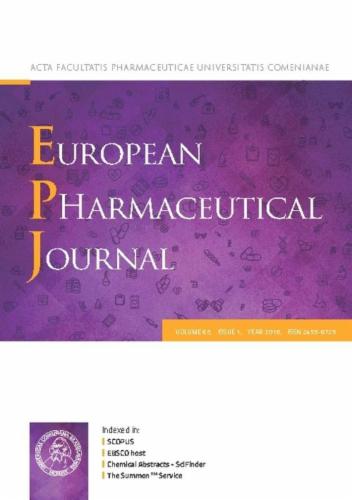Investigation of flurbiprofen pharmacokinetics in rats following dermal administration of optimized cyclodextrin-based nanogel
IF 4.3
3区 医学
Q1 PHARMACOLOGY & PHARMACY
引用次数: 0
Abstract
Purpose
The main purpose of this study was to optimize a cyclodextrin-based nanogel of flurbiprofen (FP) for prolonged dermal administration and evaluate its stability, in vitro release, ex vivo skin permeation, and in vivo pharmacokinetic profile.
Methods
The nanogels were prepared via emulsification/solvent evaporation process and optimized through design of experiments. Optimal formulation was characterized via particle size (PS), polydispersity index (PDI), zeta potential (ZP), differential scanning calorimetry (DSC) and X-ray powder diffraction (XRPD), solubility, stability, in vitro release/ex vivo permeation studies and mathematical modeling, and pharmacokinetic studies conducted in rats. Results were compared to HPMC-based gel that was not nano-sized (i.e.FP-HPMC gel).
Results
The PS, PDI and ZP values of optimal FP-loaded nanogel were 295.5 nm, 0.361 and -31.9 mV, respectively and it was stable for 12 months. In in vitro release studies, the flux from the optimal FP-loaded nanogel (96.3 µg/hcm2) was three times slower (i.e.more controlled) than that of the FP-HPMC gel (287 µg/hcm2); the permeability coefficient of the nanogel (0.015 cm/h) was slightly less than that of FP-HPMC gel (0.046 cm/h). Rat skin studies showed FP-loaded nanogel provided higher drug retention in the skin, compared to FP-HPMC gel. Mathematical modeling from rat skin permeation showed the Hixson-Crowell model was the best fitting model for FP-loaded nanogel, suggesting surface area of the nanogel is changing during the release process. In rat pharmacokinetic studies, the FB-loaded nanogel exhibited prolonged and flatter plasma profile than the FP-HPMC gel, consistent with the higher drug retention in the skin.
Conclusion
The optimized nanogel provided prolonged drug permeation and more sustained pharmacokinetic performance compared to FP-HPMC gel.
经皮给药优化环糊精纳米凝胶后氟比洛芬在大鼠体内的药动学研究。
目的:优化环糊精基氟比洛芬(FP)纳米凝胶的长效皮肤给药性能,并评价其稳定性、体外释放度、体外透皮性和体内药动学特征。方法:采用乳化/溶剂蒸发法制备纳米凝胶,并通过实验设计进行优化。通过粒径(PS)、多分散性指数(PDI)、ζ电位(ZP)、差示扫描量热法(DSC)和x射线粉末衍射(XRPD)、溶解度、稳定性、体外释放/体外渗透研究和数学建模以及大鼠药代动力学研究对最佳配方进行了表征。将结果与非纳米级的hpmc凝胶(即fp - hpmc凝胶)进行比较。结果:最佳负载fp纳米凝胶的PS值为295.5nm, PDI值为0.361,ZP值为-31.9mV,稳定性为12个月。在体外释放研究中,最佳FP-HPMC纳米凝胶(96.3µg/hcm2)的通量比FP-HPMC凝胶(287µg/hcm2)慢3倍(即更可控);纳米凝胶的渗透系数(0.015cm/h)略小于FP-HPMC凝胶的渗透系数(0.046cm/h)。大鼠皮肤研究表明,与FP-HPMC凝胶相比,负载fp的纳米凝胶在皮肤中提供了更高的药物保留率。大鼠皮肤渗透模型表明,Hixson-Crowell模型是最适合fp负载纳米凝胶的模型,表明纳米凝胶在释放过程中表面积发生了变化。在大鼠药代动力学研究中,负载fb的纳米凝胶比FP-HPMC凝胶表现出更长更平坦的血浆谱,这与皮肤中更高的药物保留率一致。结论:与FP-HPMC凝胶相比,优化后的纳米凝胶具有更长的药物渗透时间和更持久的药代动力学性能。
本文章由计算机程序翻译,如有差异,请以英文原文为准。
求助全文
约1分钟内获得全文
求助全文
来源期刊
CiteScore
9.60
自引率
2.20%
发文量
248
审稿时长
50 days
期刊介绍:
The journal publishes research articles, review articles and scientific commentaries on all aspects of the pharmaceutical sciences with emphasis on conceptual novelty and scientific quality. The Editors welcome articles in this multidisciplinary field, with a focus on topics relevant for drug discovery and development.
More specifically, the Journal publishes reports on medicinal chemistry, pharmacology, drug absorption and metabolism, pharmacokinetics and pharmacodynamics, pharmaceutical and biomedical analysis, drug delivery (including gene delivery), drug targeting, pharmaceutical technology, pharmaceutical biotechnology and clinical drug evaluation. The journal will typically not give priority to manuscripts focusing primarily on organic synthesis, natural products, adaptation of analytical approaches, or discussions pertaining to drug policy making.
Scientific commentaries and review articles are generally by invitation only or by consent of the Editors. Proceedings of scientific meetings may be published as special issues or supplements to the Journal.

 求助内容:
求助内容: 应助结果提醒方式:
应助结果提醒方式:


